If you are a runner with flat feet, your shoes can make all the difference. Don’t let missteps cause potential injury and issues down the road. Choosing the best running shoes for flat feet now will make you feel physically better in the short-term, and alleviate potential serious problems in the long term.
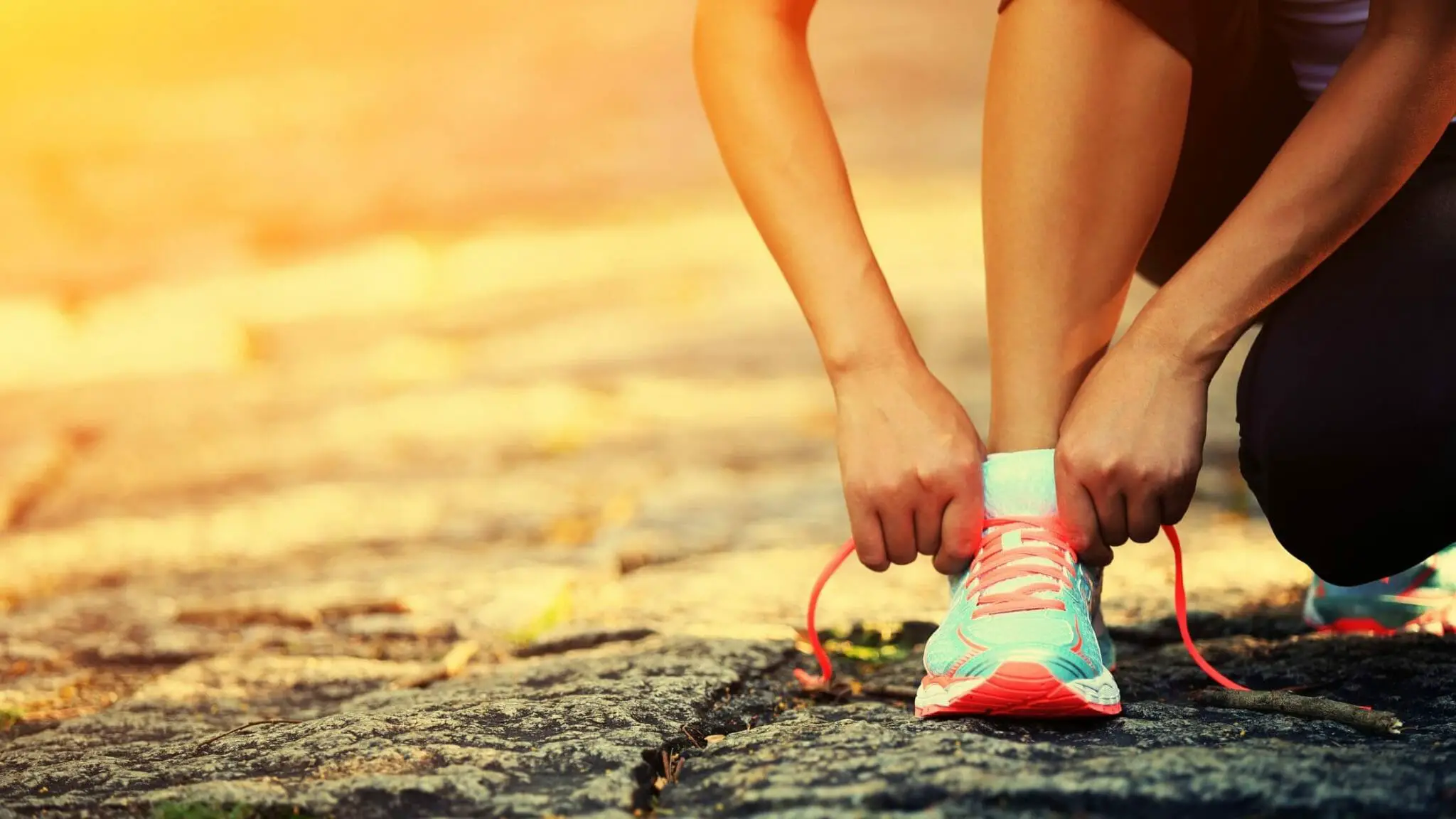
How We Tested the Best Running Shoes for Flat Feet
At ShoeGuide we put a tremendous amount of research into the shoes we select. To pick out the best running shoes for flat feet, we suggest you take some time to read into proper shoe anatomy in our article Anatomy of the Shoe.
Doing so can familiarize you with the proper terminology, and point out some important things to watch for when researching and buying running shoes for flat feet.
There are two main types of shoes that podiatrists recommend for those with flat feet: stability shoes and motion control shoes.
- Stability shoes are ideal for those with mildly collapsed arches, as they provide extended support for the foot arch as a priority.
- Motion control shoes are meant for people who have severely fallen arches, as motion control shoes restrict improper movement when running. These shoes offer strong arch support and an extremely stiff heel. These are the best option if you are looking for running shoes for overpronation and flat feet.
In order to really put these shoes to the test, we first did a lot of research for each of the top brands to see which of their shoes were designed for flat feet. Then we grabbed a ton of shoes (in conjunction with testing for our article on plantar fasciitis running shoes).
Next we started logging miles in various conditions. The three primary routes that we conducted tests in were a standard flat route, an off-road route that was mostly dirt and gravel, and a stair climbing route for those who wanted to know how these things stood up to really heavy use.
Our Choices for the Best Running Shoes for Flat Feet in 2022
First, we have developed a summary table showing what we consider to be the best running shoes for people with flat feet. Below the table you'll find our quick summary of each shoe, along with links to our full blown reviews. We definitely recommend reading the full reviews!
Here are our top picks:
- Best Overall: Brooks Adrenaline GTS 22 - Men's | Women's
- Runner Up: Asics Gel-Kayano 28 - Men's | Women's
- Best Nike for Flat Feet: Nike React Infinity Run Flyknit 2 - Men's | Women's
- Best Supportive-Neutral Running Shoe: Brooks Ghost 14 - Men's | Women's
- Max Cushioning and Arch Support: New Balance Fresh Foam X 860v12 - Men's | Women's
- Best for Overpronators: adidas Solarglide 4 ST - Men's | Women's
- Best Stability Running Shoe: Mizuno Wave Inspire 17 - Men's | Women's
- Nike for Flat Feet on a Budget: Nike Air Zoom Structure 24 - Men's | Women's
- Best if You Love Mizuno: Mizuno Wave Horizon 5 - Men's | Women's
- Best Saucony for Flat Feet: Saucony Guide 14 - Men's | Women's
Detailed Review of the Best Running Shoes for Flat Feet
1. Brooks Adrenaline GTS 22
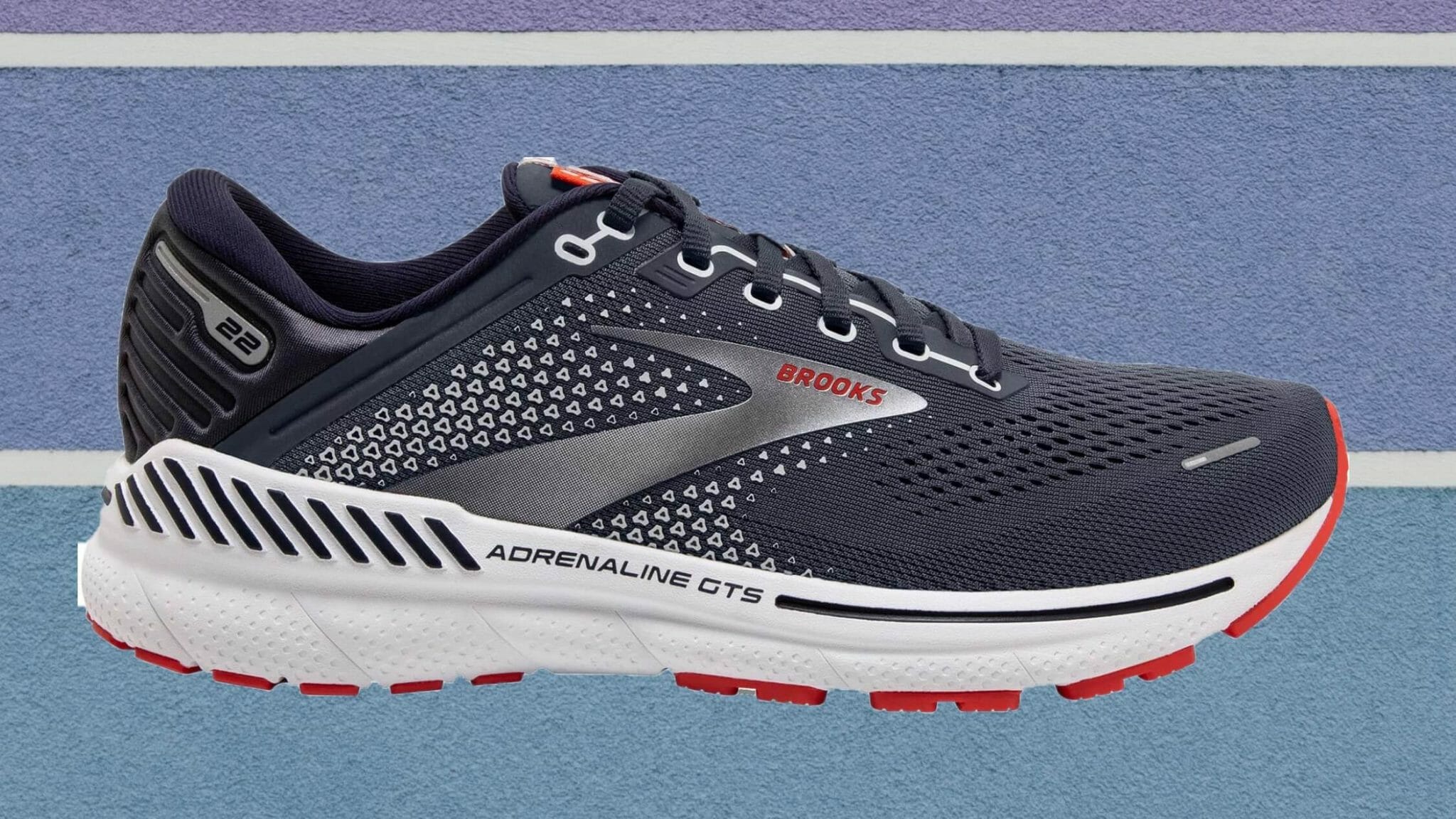
Available for Men at
Available for Women at
The changes keep coming from Brooks with the Adrenaline GTS 22. The Adrenaline continues to evolve and incorporate newer design features in the support running shoe category. We think these changes improve the performance, the cushioning, and the arch support of the Adrenaline line.
The most noticeable change over the the past few years is that Brooks dropped the medial post design and replaced it with "guide rails". This is the Brooks jargon for a shoe with higher midsole sidewalls that keep the foot in place and prevent rolling during your run. This takes it out of the traditional stability shoe category, though the run still feels like a traditional stability running shoe in many respects.
Although both the Adrenaline GTS 22 and the Ghost 14 from Brooks adopt the single-density foam midsole for a smoother rider, the Adrenaline GTS 22 features a Guide Rail made from a firmer, denser foam to give added arch support. You wouldn't be far wrong if you simply thought of the Adrenaline GTS 22 as a Ghost 14 with additional support under the arch. And that's not a bad thing! This is one of the most comfortable Adrenaline models produced by Brooks to date, and can serve as an everyday runner or for long-distance road running.
The upper and outsole are pretty standard Brooks running shoe fare. Lots of padding and cushioning without veering into overkill, but definitely not the super lightweight uppers you'll find on offerings from Nike. One other difference between the Adrenaline 22 and the Ghost 14 is the gusseted tongue to keep out pebbles and other small debris.
2. Asics Gel-Kayano 28
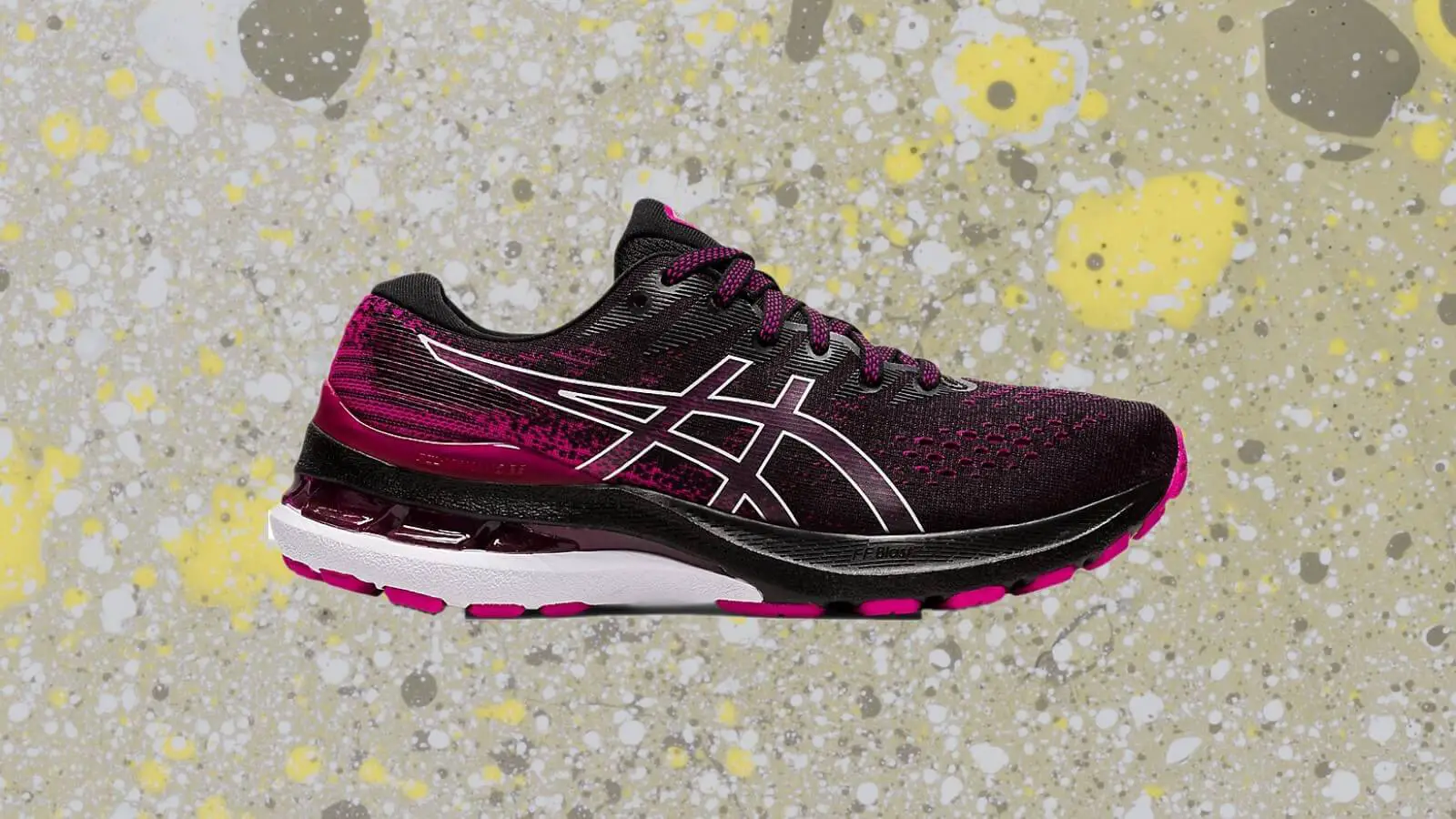
Available for Men at
Available for Women at
Asics has long been one of the friendliest brands for runners with flat feet. These shoes, the Gel-Kayano 28, are no exception, being one of the most stable running shoes for both men and women. As many brands have ditched their medial post design in their stability models, Asics continues with this design. It provides extensive support for those with over pronation associated with flat footedness. If you like this more classic approach to a stability running shoe, then the Kayano 28 gives you a solid option.
Features
- Classic Design. While other models undergo radical changes, Asics keeps the Gel-Kayano line of running shoes largely unchanged. This is great if the Kayano works well for you, but you just want a slightly upgraded model. The basics of the support, ride, cushioning, and performance have not changed substantially from earlier models.
- Firmer Wedge. Another traditional design from the stability running shoe playbook, the firm wedge on the Kayano coupled with a plastic midfoot shank provide great fit and comfort for many flat footed runners.
- FF Blast Cushioning. Focused on crafting cushioned midsoles with improved responsiveness, comfort, and stability, while remaining surprisingly lightweight.
- GEL Technology Cushioning. Gives a cushioned heel strike with strong durability and shock absorption.
Differences between the Gel-Kayano 28 and the Gel-Kayano 27
All the changes from the previous model are minimal in this iteration, one area that stands out immediately is the softer forefoot. The Flytefoam Blast definitely feels softer while running than the forefoot feel of the 27. This makes the Gel-Kayano 28 an excellent choice for daily and longer-distance runs. Pushing it further in this direction is the 11-ounce weight, making it less ideal for tempo days or short distance races.
Final Thoughts
One last thing to note is that Asics does build the men's and women's models with some differences. The women's running shoe has a 2mm thicker heel and a 1mm lower forefoot. These changes also give a heal-to-toe drop of 13mm for the women's version versus the 10mm found for the men's.
3. Nike React Infinity Run Flyknit 2
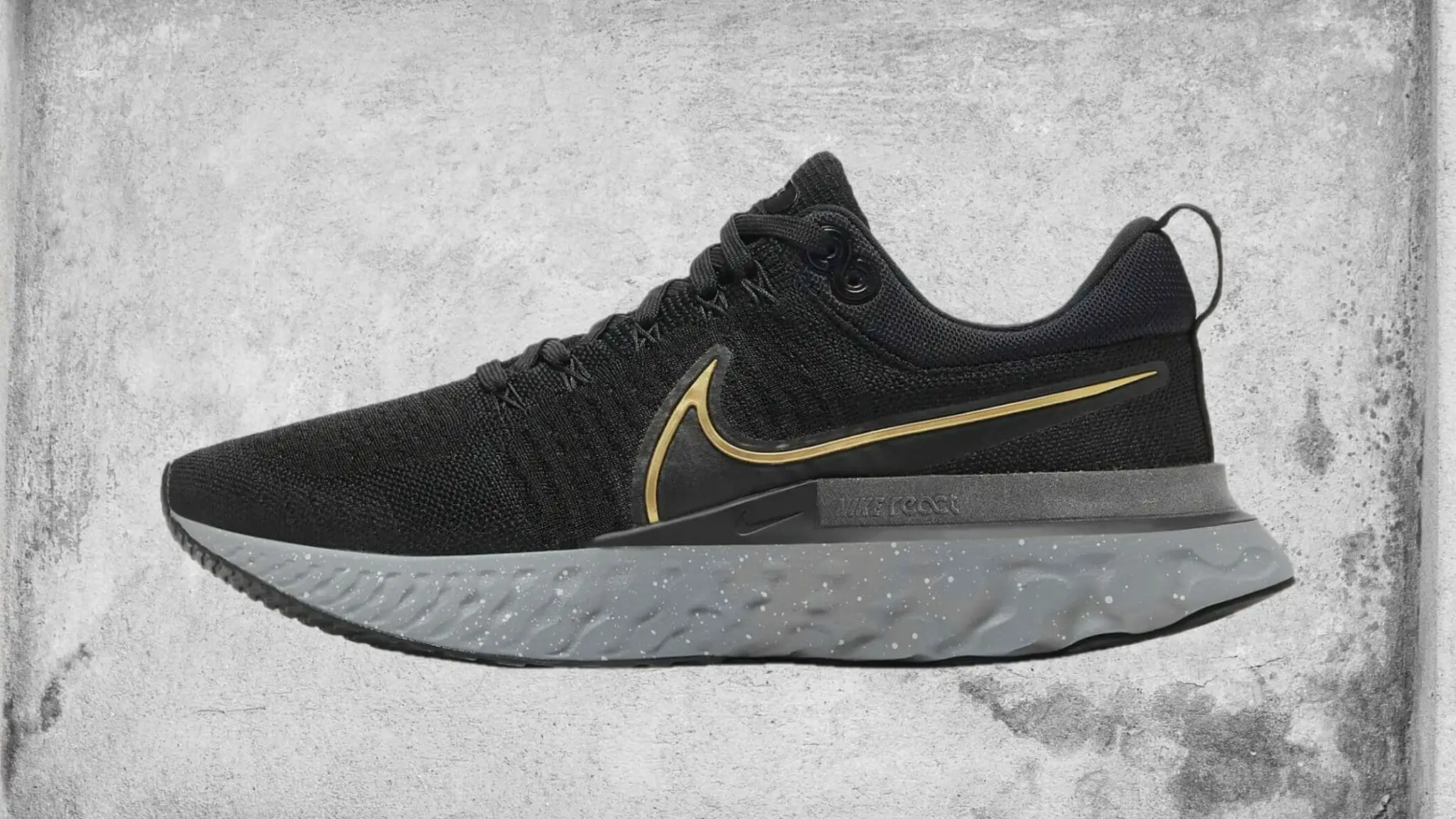
Available for Men at
Available for Women at
With good reason, Nike is the most well-known shoe brand in the world. Nike is synonymous with high quality, extreme durability, and the forefront of technology. The React Infinity Run running shoe is no exception. A stellar training and running shoe, this option provides incredible arch support for runners with low arches.
Comparison with the Zoom Structure 24
The Nike React Infinity Run is an alternative to the Zoom Structure line-up and makes use of Nike's new guide rail system. This system is similar to the system that Brooks Running switched to in their shoes for the last couple of years.
Nike believes this model provides a definite upgrade on the Zoom Structure:
In fact, an external study by the British Columbia Sports Medicine Research Foundation (BCSMRF) on 226 runners in the Nike React Infinity Run and the Nike Structure 22, a traditional motion control shoe, showed that runners in the Nike React Infinity had a 52 percent lower injury rate than in the motion control shoe, with wearers confirming that they felt less pain in their knees and feet.
Features
These shoes feature midsoles with triple the density of most running shoes, making them perfect for people with flat feet. This provides owners with insole foam mid-foot, and a sturdy foam wedge at the heel, while still maintaining impressive breathability through fly-mesh uppers with mesh inner sleeves.
This technology keeps the feet cool and dry, while providing a secure fit. Additionally, the outsoles have a signature Nike waffle texture, providing users with solid traction on any running surface, as well as rubberized "crash rails", providing smoother transitions with steps and when changing surfaces. The movement-responsive React Infinity Run structuring of the front provides flexibility in speed, as well as comfortable cushioning without extensive bulk added.
This shoe was designed specifically for those suffering from flat-footedness, and is available for both women and men.
4. Brooks Ghost 14
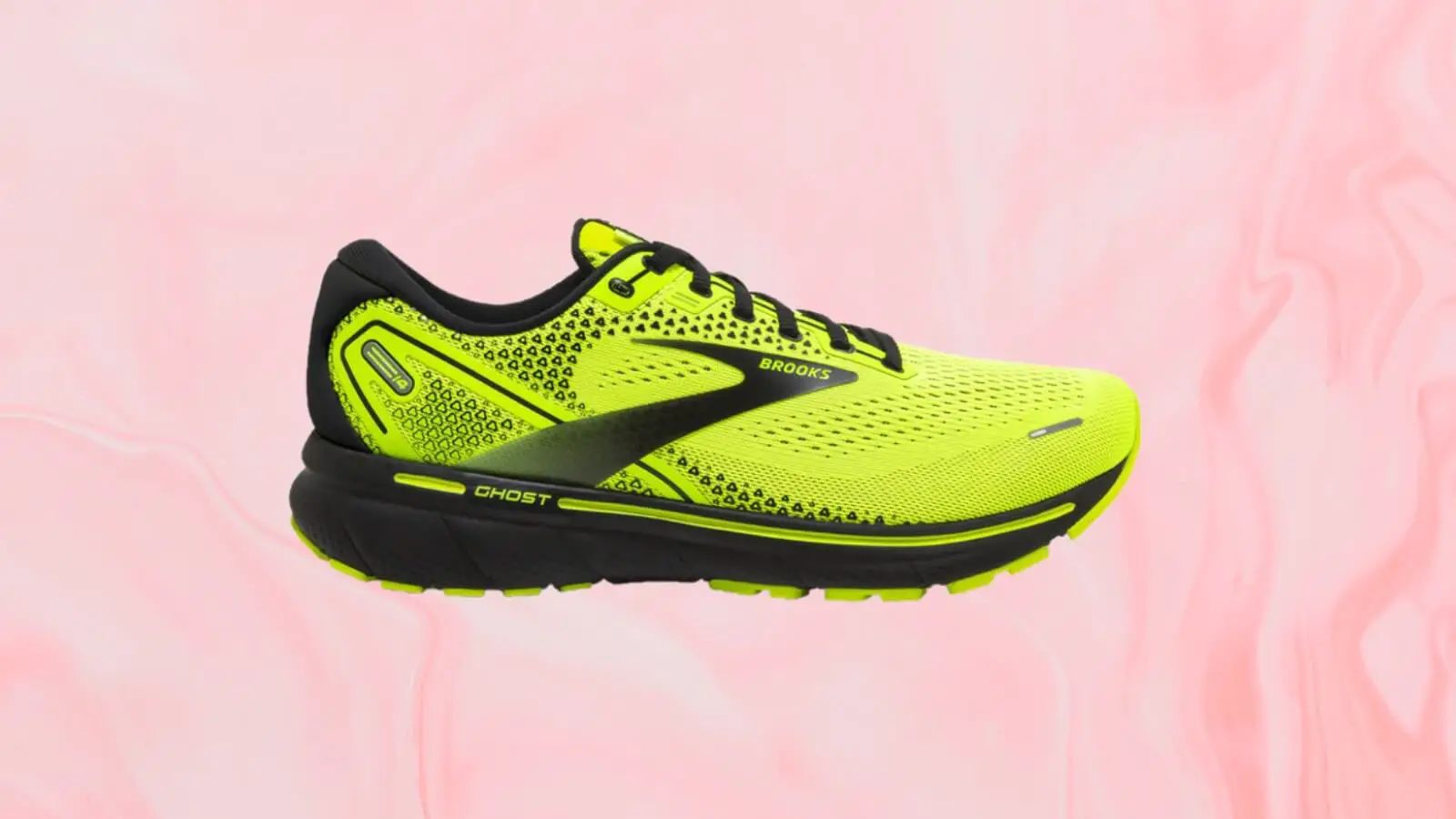
Available for Men at
Available for Women at
The Brooks Ghost model consistently ranks as one of the most popular running shoes on the market. Now into its 14th iteration, the Ghost has all the features to make it a crowd-pleasing neutral support running shoe. Each of the features come together in the right mixture to give a comfortable ride for runners with flat feet.
With the Ghost 14, Brooks Running follows the advice of Roman dramatis Plautus, "Moderation in all things is the best policy." The cushioning, the stability of the ride, the padded upper are all there, but none of them overwhelm the others, or the shoe as a whole. This all makes it a great choice for runners with moderate to sever flat feet, but without any accompanying overpronation or gait issues that call for a more robust motion control shoe.
Upgrades to the Ghost 14 from the Ghost 13
In the previous iterations of the Ghost model, Brooks used a separate piece of foam for the heel crash pad. Brooks jettisoned that approach starting with the 13, and continue that design change with the 14. Instead Brooks uses a one-piece midsole that gives a smoother ride. Given its popularity with runners, we expect this design to change to continue in future models.
That said, the Brooks Ghost 14 still feels like a Brooks Ghost running shoe you might be used to from previous versions. The upper still features a padded mesh construction that is on the heavier side compared to rivals, but is not overwhelming. We still think it's probably not the best option if you're running in really hot conditions as all that padding doesn't breath as well as a thinner mesh upper (as you might find on the Nike Fly Knit models). Of course, this extra padding is great if you have bunion, bone spurs, or any other foot issues that might benefit from a little extra TLC in the upper.
5. New Balance Fresh Foam X 860v12
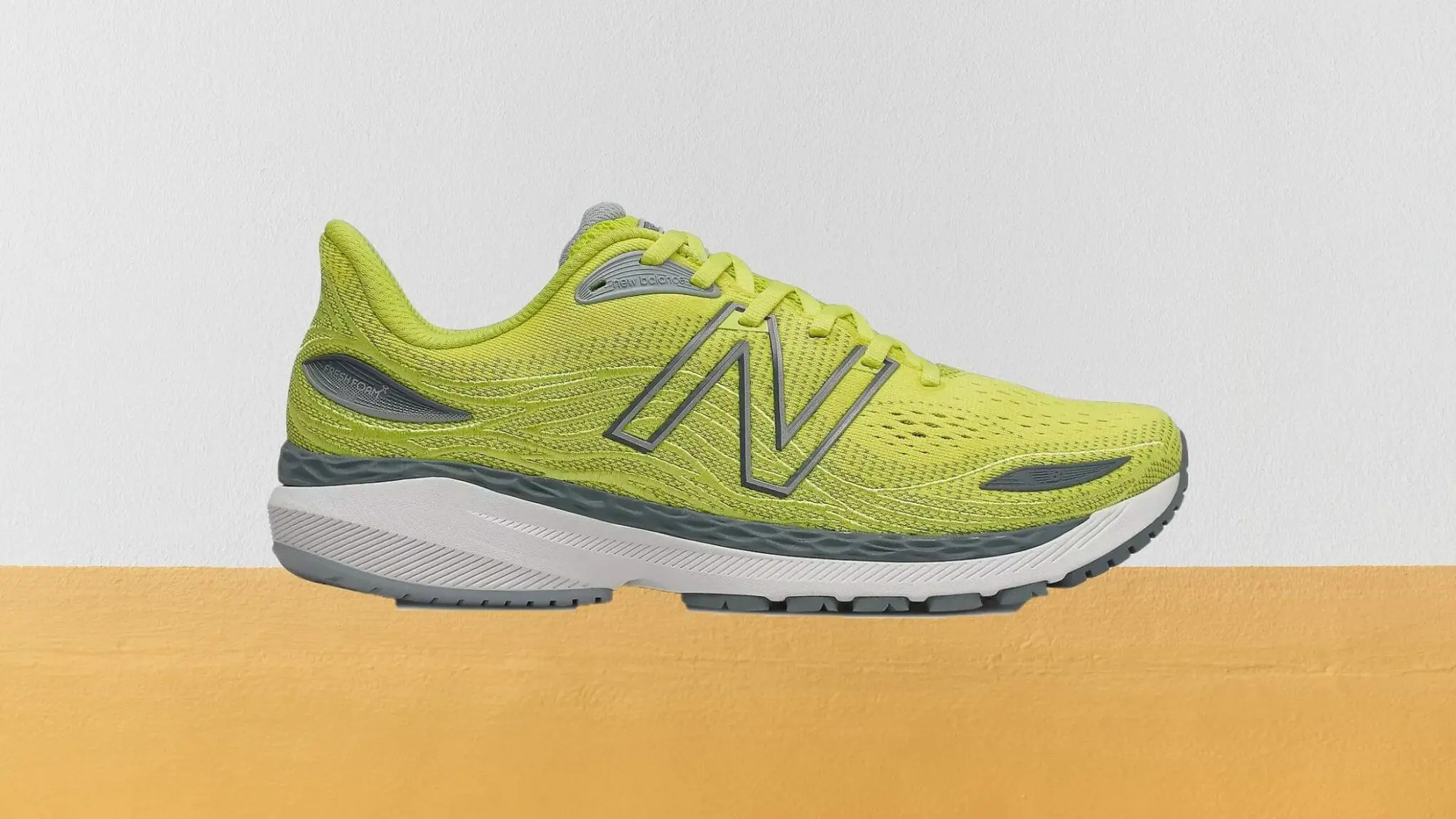
Available for Men at
Available for Women at
New Balance is one of the most prominent, and well-respected brands in the running shoe world today. They produce top notch running shoes for almost every niche, type of running, and foot condition you can think of. These shoes, the 860v12, are part of New Balance's flagship 800 series which provide excellent cushioning. The 860 model is the stability model in the 800 series, and is ideal for runners with flat feet and overpronation.
Some important features of the 860v12 are
- Dual Density Midsole. With two layers of foam, each with a different density and attached by New Balance's TruFuse technology. This dual-density midsole provides the cushioning of a thick foam sole without sacrificing responsiveness.
- Medial Post. Provides a stable, firm ride that cushions your feet and helps correct over pronation.
Generally billed as a "moderate" stability shoe, our experience is that it definitely provides a serious amount of stability, but is surprisingly light for a stability shoe. This combination is ideal for most flat footed runners, and is one of the reasons it gets our top spot.
The other reasons that it takes the top position are: durability, comfort, cushioning, and price. The blown rubber outsole will stand up to some serious miles of road running. The breathable mesh upper keeps your feet cool and secure. The cushioning is second-to-none as that's one of the major design features New Balance built into the whole 800 line-up. Finally, it isn't cheap, but it's certainly not the most expensive shoe on our list.
Overall a great value, and the ideal choice for most runners with flat feet.
6. adidas SolarGlide 4 ST
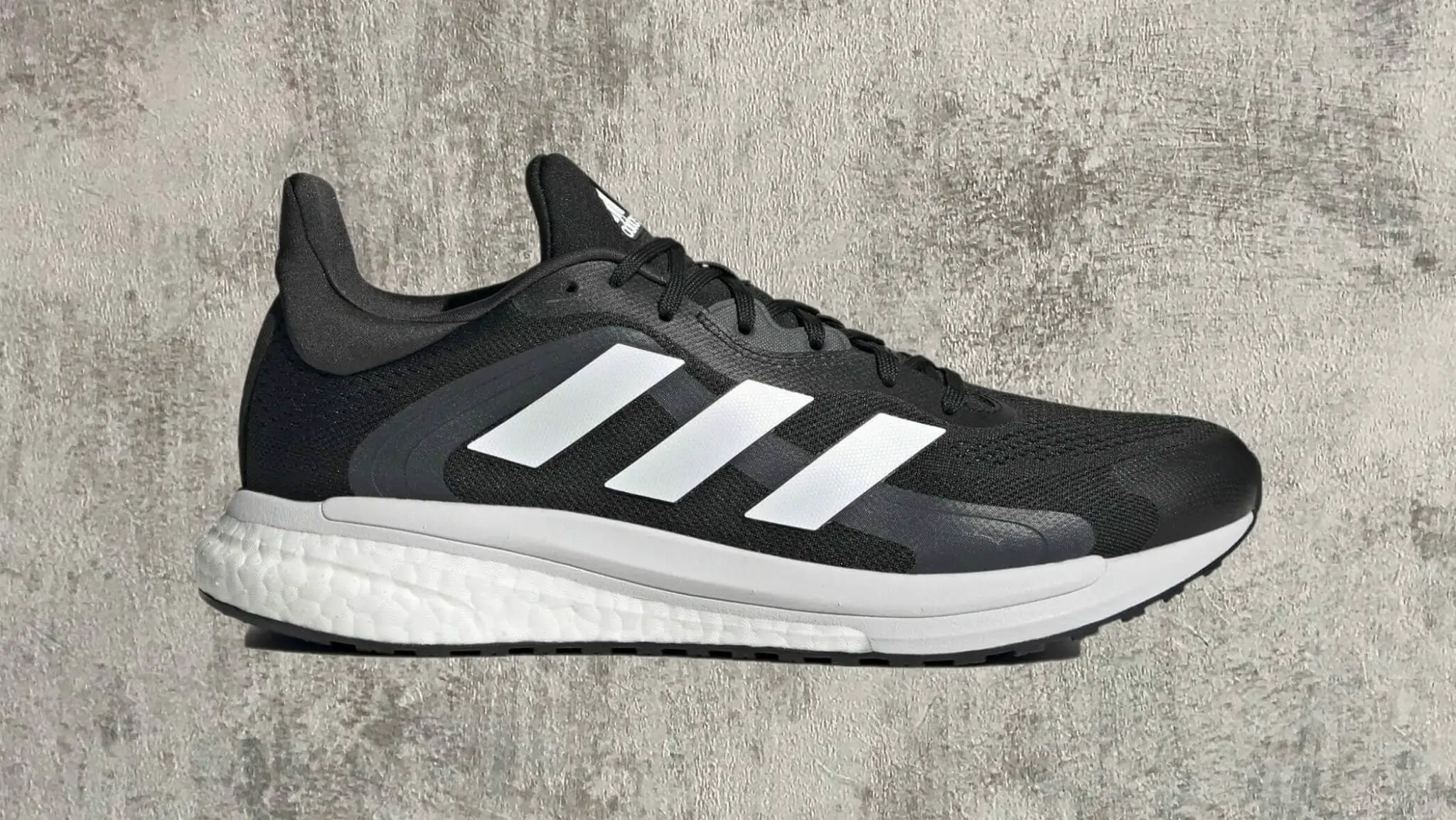
Available for Men at
Available for Women at
Hey, do you like adidas? Do you overpronate? Great, here's the shoe for you! Designed by adidas specifically for overpronators, the Solarglide ST 4 recognizes that every runner has different needs and different strengths. When you overpronate, your stride can impact every aspect of your run, including the fit and feel of your shoes.
The "ST" nomenclature at the end of an adidas running shoe indicates a stability model. Although adidas did away with some of these over the past two years, the Solarglide continues to provide a stability option at a midrange price point. It's not cheap, but is substantially less than adidas flagship models such as the Ultraboost.
The idea behind the adidas Solarglide ST is to provide support for a flatter arch and help eliminate discomfort associated with the inward foot role of overpronators. The Solarglide ST addresses this by using a denser version of the famed Boost midsole on the medial side of the shoe. This both stabilizes the foot and provides additional energy return during your run.
One further detail is the heel counter. This is a critical feature if you have any foot pain, as locking the heel in place reduces the work your plantar fascia does. This can reduce pain that develops during or after your run.
7. Mizuno Wave Inspire 17
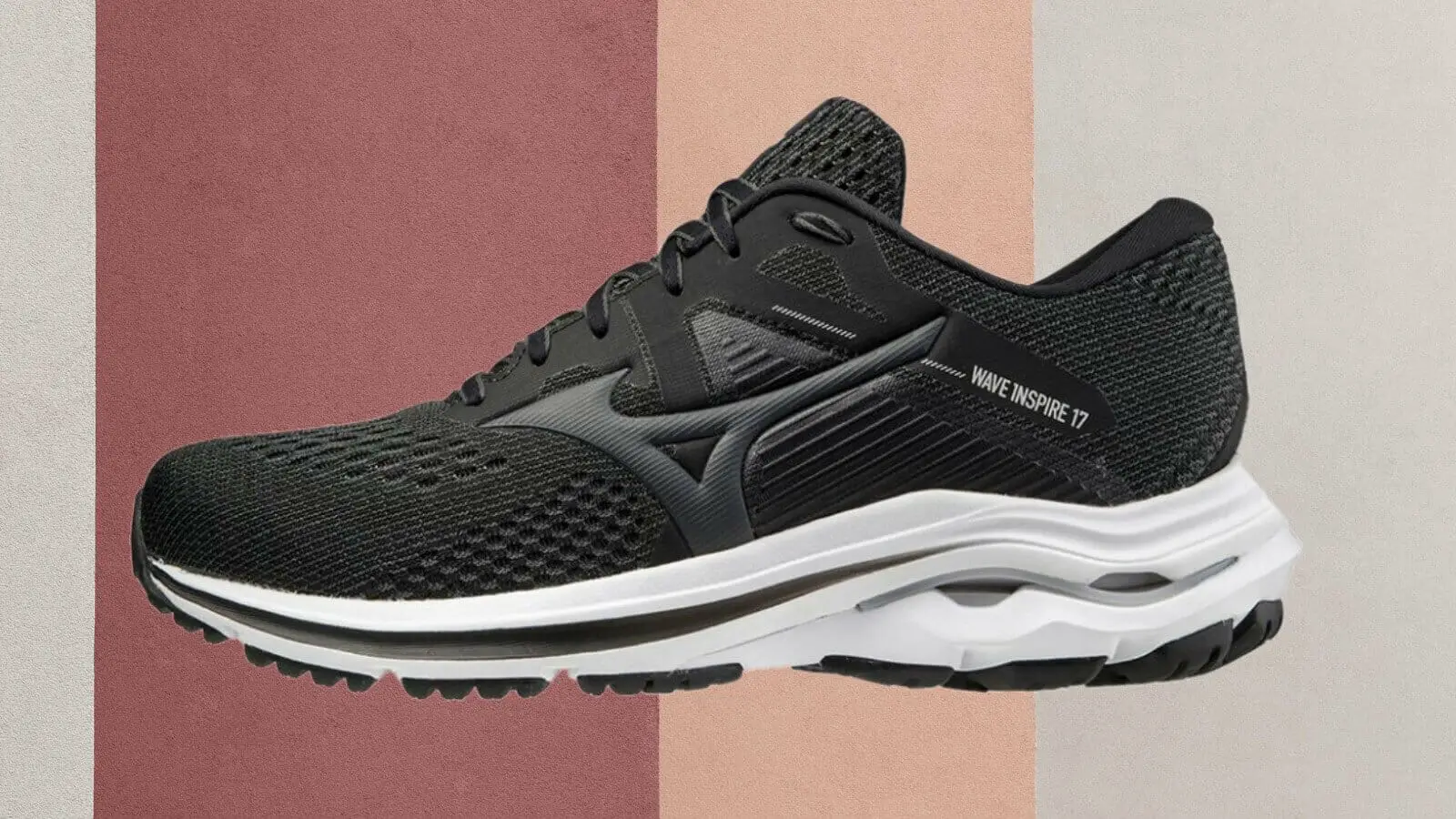
Available for Men at
Available for Women at
Having flat feet and suffering from over pronation should not hinder your ability to enjoy a nice run. The Mizuno Wave Inspire 17 hits all the high notes, designed for both men and women to assist with flat footedness. The Wave Inspire are notorious for their stability benefits, light weight and low profile.
The Mizuno Wave Inspire has U4iC boards, as well as double fan wave technology made common with Mizuno shoes. This technology assists in absorbing shock that the body and feet experience when running, and offer durability without the additional weight.
The Mizuno Wave Inspire 17 boast less weight than any other shoe on our list. The technologies apparent in the Mizuno brand provide more cushion, reducing the wear on your feet, extending running longevity. The insoles can be removed on these shoes, allowing users to insert their own orthotics as needed.
The Wave Inspire are a great option for those with over pronation and flat feet looking for a great option to keep the weight down. There are choices for women and men, and have multiple colors and styles.
8. Nike Air Zoom Structure 24
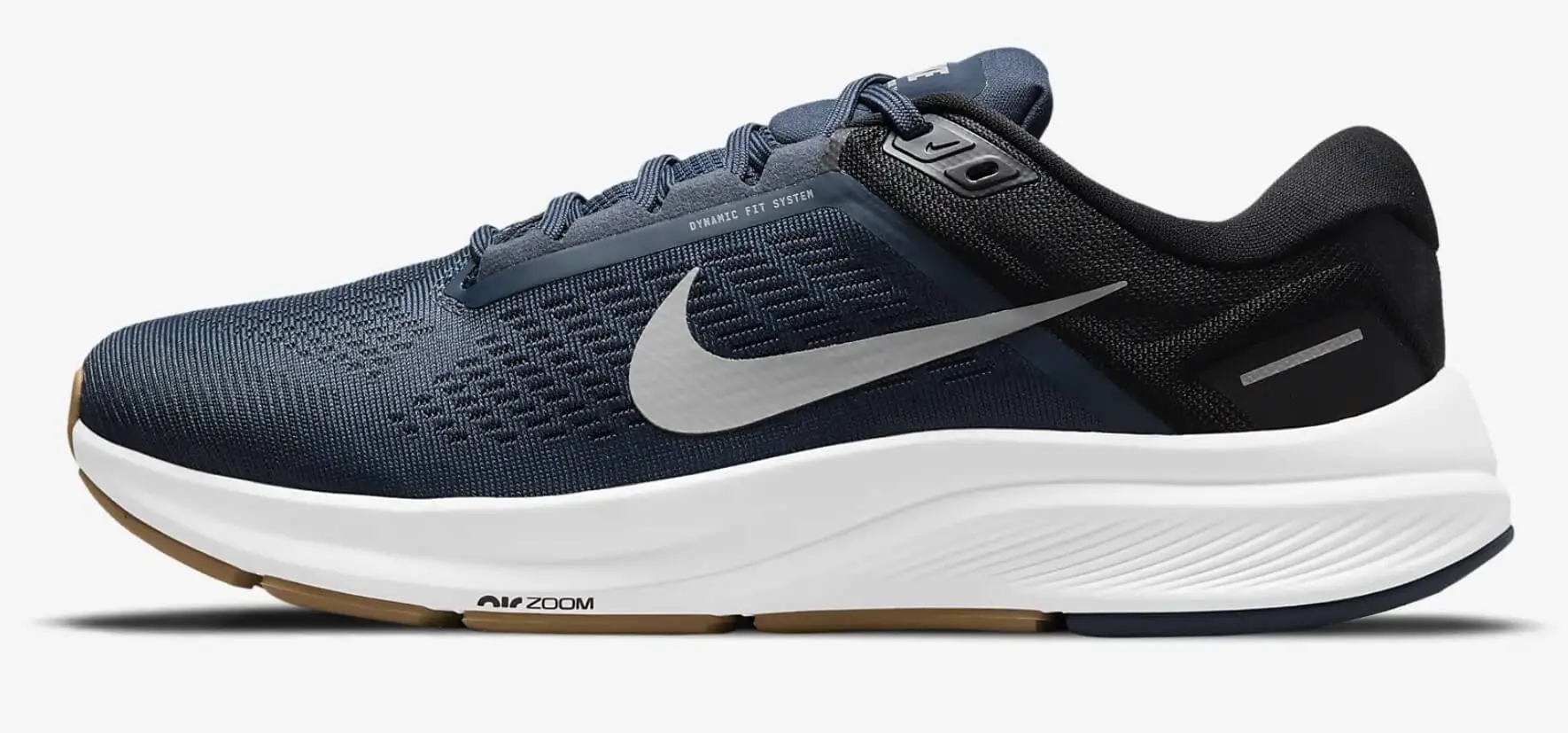
Available for Men at
Available for Women at
Perhaps more than any other shoe on our list, the Nike Air Zoom Structure series has undergone massive changes in the past two years.
Comparison with the Structure 22 and 23
Nike made huge changes to the Air Zoom Structure model when it introduced the Air Zoom Structure 23 in September 2020. Out went the medial post, a mainstay of the Structure design since the beginning. This allowed Nike to give the Structure 23 a much softer feel than the 22. The newest iteration, the Zoom Structure 24 follows the path blazed by the 23, having no medial post and a much softer ride than the old Structure 22.
Those changes aside, the Structure 24 is nearly identical to the 23. The rollout of this shoe was quite bizarre. Nike quietly discontinued the Structure line with the 22, only to rollout the Structure 23 almost two years later with the radical design overall. The 23 only stayed on shelves for a few months before it too disappeared. Finally, Nike rolled out the Zoom Structure 24, a shoe nearly identical to the 23. We're not sure what the plan to this stop-start release schedule was, but the Air Zoom Structure 24 now firmly establishes Nike's commitment to the Structure series.
Features of the Air Zoom Structure 24
Despite the design changes from the 22, the Structure 24 is still a support-oriented running shoe with a wide midsole and snug-fitting upper. This shoe is a supportive-neutral running shoe, and provides a lower price point Nike option for those that find the React Infinity Run too soft and unresponsive.
This supportive-neutral targeting makes the Structure 24 a medium-soft shoe that gives you a lot of versatility. It's more responsive than many of the more cushioned options on our list, and provides a nice option for higher paced runs.
9. Saucony Guide 14
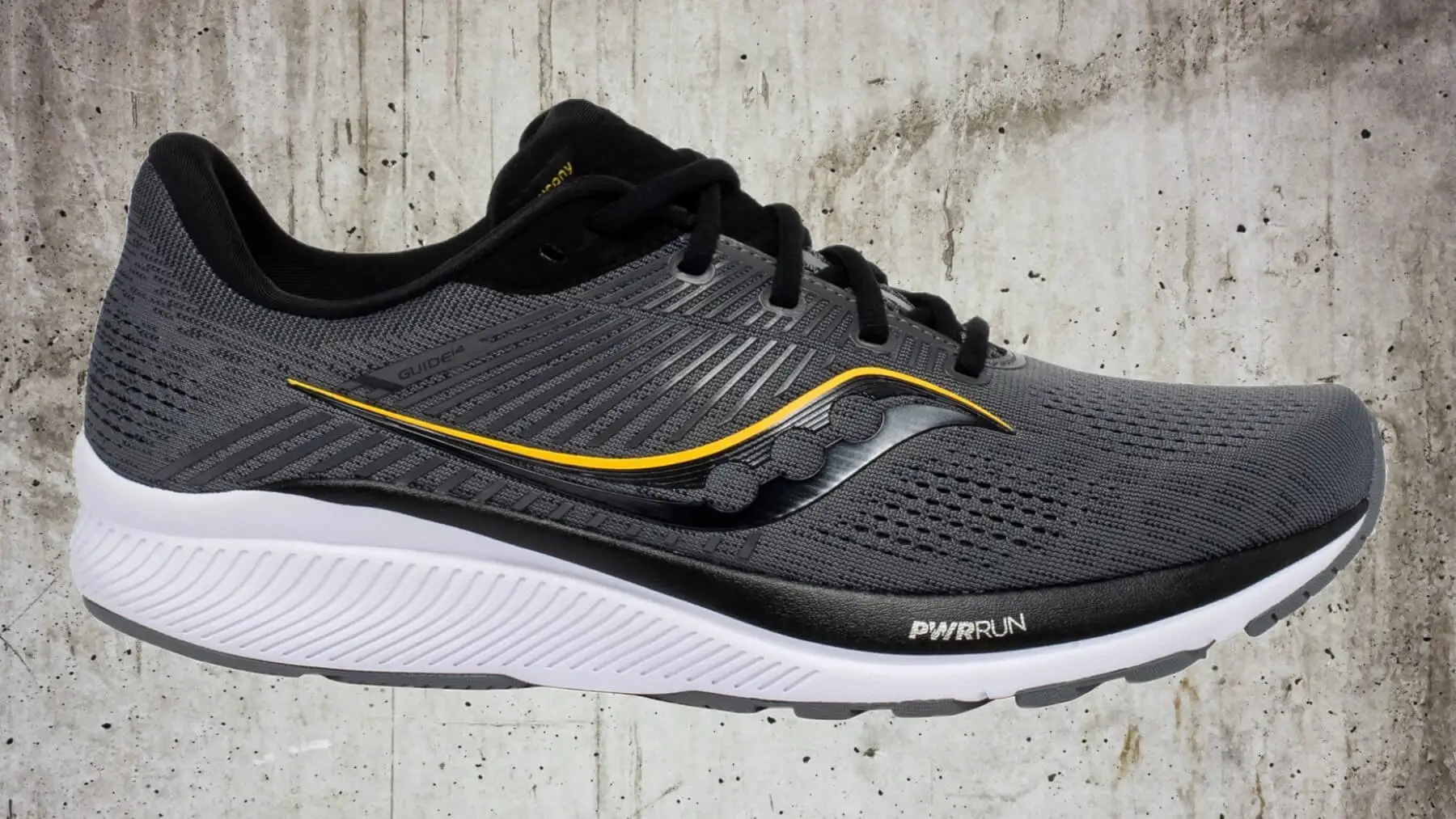
Available for Men at
Available for Women at
If you’re looking for a stunning pair of stability running shoes for flat footedness, we strongly advise checking out the Saucony Guide 14. These are ideal for those with overpronation that is not so severe, providing solid arch support without going too far.
These shoes boast multiple advanced features not found in common running shoes, including:
- Dual-density EVA material that is durable and lightweight
- An SRC landing zone to assist with shock absorption
- Saucony’s PWRRUN top-sole, providing cushioning effect for all strides
- Flexfilm provisions for additional support when running
Additionally, the Saucony Guide 14 have breathable fabric lining and mesh uppers, thick collar and tongue padding, and removable insoles to assist those who have orthotics. The Guide’s outsole can flex in multiple directions to provide better ground contact. Finally, injection rubber in multiple areas of the shoe provides cushioning, and carbon rubber provides stronger traction.
The Saucony Guide is designed specifically for those suffering from flat-footedness, and is available for both women and men, with a vast expanse of color options.
10. Mizuno Wave Horizon 5
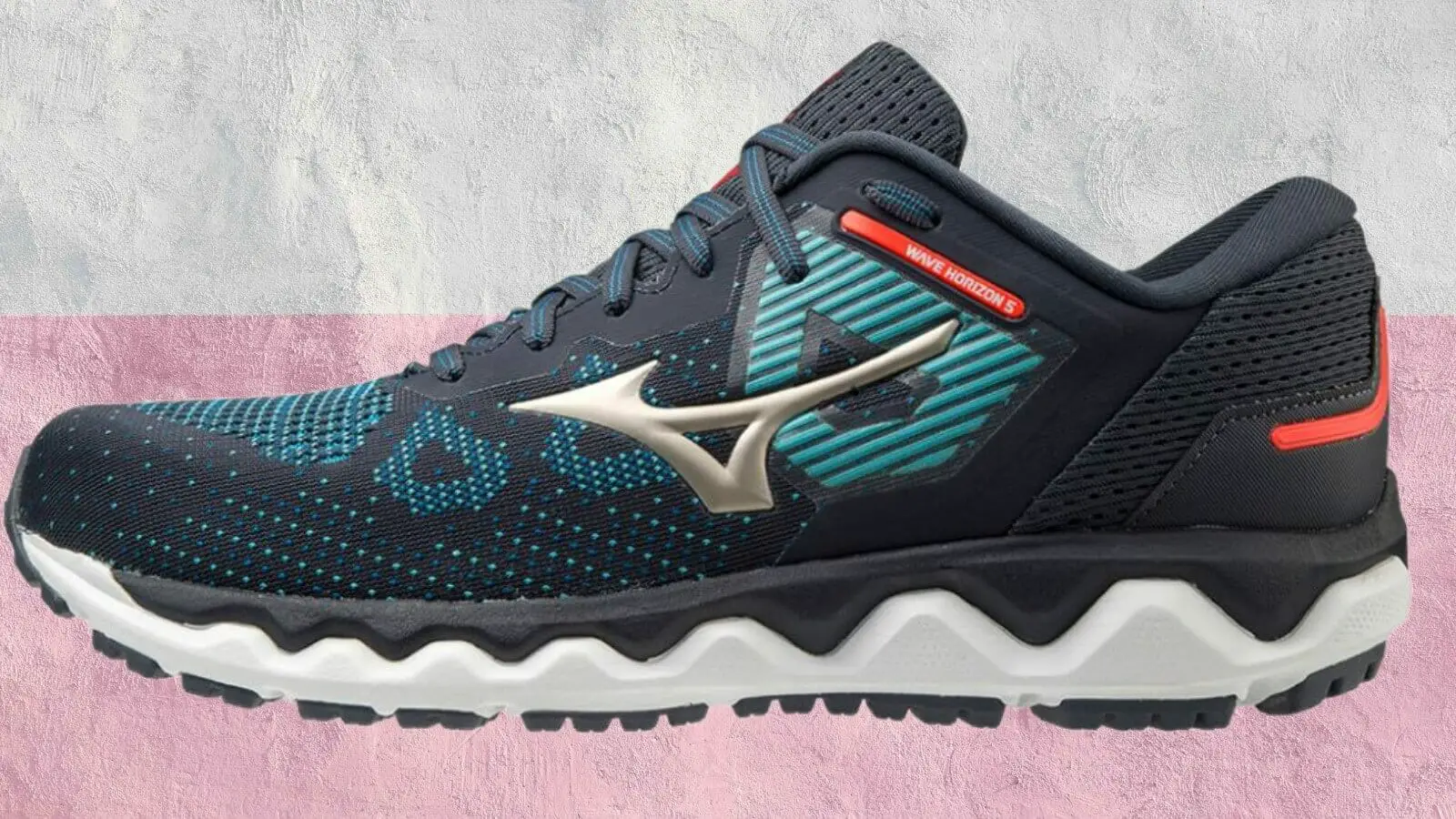
Available for Men at
Available for Women at
The Wave Horizon 5 has not been on the market for very long. However, in that time, it has become a crowd favorite for many suffering from over pronation due to flat feet. Most Mizuno shoes, especially under the Wave moniker, have incredible amounts of cushioning. The Horizon 5 is no exception.
The cushioning in this shoe is even more responsive than its predecessors, with U4iC boards for additional support in the mid-foot, and extra cushioning throughout, with varying densities of foam in the heel and toe to provide stability for areas prone to over pronation. This makes the heel to toe transition incredibly smooth, which encourages faster pacing while running.
These shoes are a great choice for people who have flat footedness and are looking for their first pair of running shoes to fit their unique needs. There are options for both men and women, with many colors and stylings to choose from.
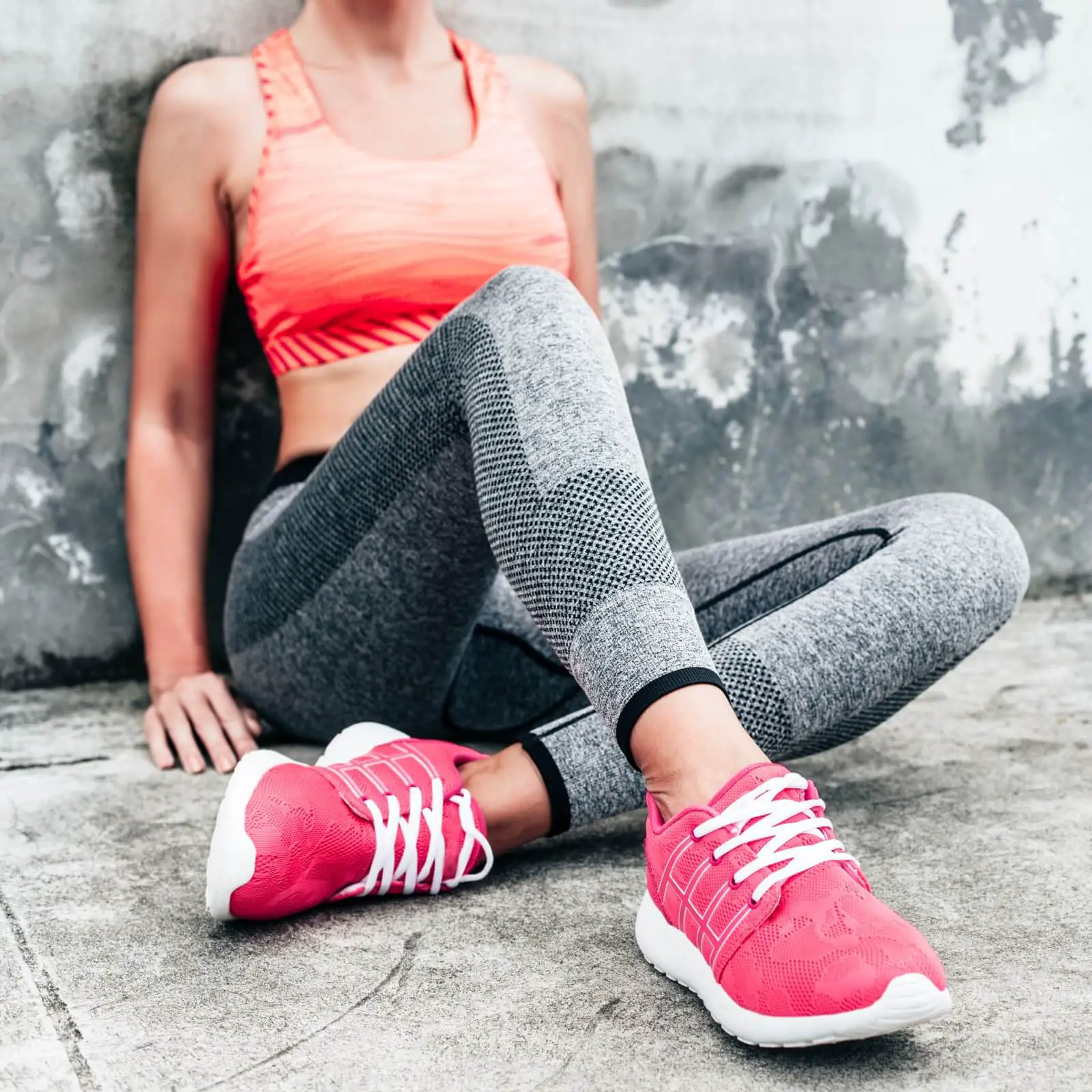
First Things First: Why Run?
Running is an incredible, inexpensive method of exercise. It’s a great way to maintain proper health, and has a stunningly long list of benefits. Just scratching the surface:
- Running can be performed anywhere. There is no equipment, no ball, no gym membership and no expensive tools required to start running. Just two working legs.
- Running gives a great excuse to eat more delicious carbohydrates, as doing so can assist in performance and mood elevation in longer runs.
- Research has shown that runners have fewer disabilities and remain active longer than their sedentary counterparts. Additionally, runners generally have longer lifespans.
- Running produces tremendous calorie burn. A 160-pound person can burn over 850 calories in an hour of running.
- Exercise has been proven to assist in memory maintenance, and can reduce symptoms of dementia and protect the brain against Alzheimer’s, even for those with family histories of the debilitating mental disease.
Struggles Apparent in Choosing Running Shoes for Flat Feet
Many runners can face serious difficulties due to improper footwear. If you are flat-footed, it is vital to purchase running shoes made specifically for people suffering from flat feet. This helps to avoid injuries both in the short- and long-term, and keeps you on track to break distance and speed personal bests, and stay in the best shape of your life.
Most runners simply select their shoes based on what is available. Others go slightly deeper and look at reviews, brands, and styles.
You do need to take care in selecting your running shoes. One area that has generated some controversy is the use of arch support in running shoes. Craig Norton at Ortho-Sport had this to say:
Arch support can improve running economy by reducing torsional forces in the lower extremety due to pronation. They are also helpful in developing a more balanced foot pattern. Again proper shoes with the right structural parameters and loaded heel to toe ratio should be considered first. Unfortunately, most shoe experts are unaware of the structural parameters of shoes they recommend, and they rely on shoe reps.
While there might be nothing wrong with the shoe itself, it might not be the most effective fit for your feet.
Additionally, foot structure constantly changes, even once growth stops in your late teenage years. Skeletons shift and lower into the foot as years’ progress. This means that, even if you did not start out flat-footed, you could be now.
In this guide, we are going to walk you through the process of selecting the best running shoes for flat feet. Our goal is to ensure you can “put your best foot forward” in your running pursuits, whether they be casual or competitive. After all, running is not just an exercise, it’s a lifestyle.
Flat Feet: Definitions and Causes
What are flat feet? In an individual with fallen arches, one or both feet might be flat on the ground. This can cause shoes to wear unevenly, especially on one side, or they might wear out faster than usual.
Many suffering from flat footedness show no serious symptoms. However, others might experience pain in their feet or back, depending on the root cause. These symptoms can vary, and will generally be dependent on the condition’s severity.
Some people have inherently uneven bodyweight distribution. These individuals may find that the heel of their shoes wear out more rapidly on one side than the other.
The most common symptom prevalent in those with flat feet is general pain. This pain will usually occur in the foot itself, especially if the connected muscles and ligaments are strained. This is something highly common in running.
Pain may also be present in the inner side of the ankle (along with telltale swelling), arch of the foot, calf, knee, hip, back, and lower leg. Abnormal stress to the knee and hip might result in pain. This is more likely if the ankles turn inwards. Additionally, flat feet can lead to lower back pain, along with stiffness in the lower body.
All of this is far more common than you might think. Research and studies have shown that almost one-quarter of the population of the United States alone suffer from fallen arches or flat feet.
What Are Some of the Causes of Flat Feet?
Some of the most common causes of flat feet include:
- Standard genetics. Sadly, flat feet can run (get it?) in families.
- Weaker arches. When the arch can be seen when sitting, sometimes the foot flattens onto the ground when weight is put on it. This is flat feet due to weak arches.
- Historic ankle or foot injuries.
- Rheumatoid or standard arthritis affecting the lower extremities.
- Rupturing, dysfunction, or damage of the posterior tibial tendon.
- Muscle or nervous system diseases, like spina bifida, muscular dystrophy, or cerebral palsy.
Additionally, tarsal coalition can cause flat feet. This is a condition causing strange fusing of the bones of the foot, resulting in stiff and flat feet. People are also more likely to develop flat feet during pregnancy, or if they are obese or suffer from diabetes.
Also, flat footedness can develop as people grow older. Daily usage causes the posterior tibial tendon to weaken. This tendon acts as a support structure for the arches. Inflammation of this is what is commonly known as tendinitis. Damage to this tendon can cause the arch of the foot to flatten out.
This may all sound scary, and you might be asking “How do I know if I have flat feet?” Luckily, there are a few tests that can be performed to give you a good idea.
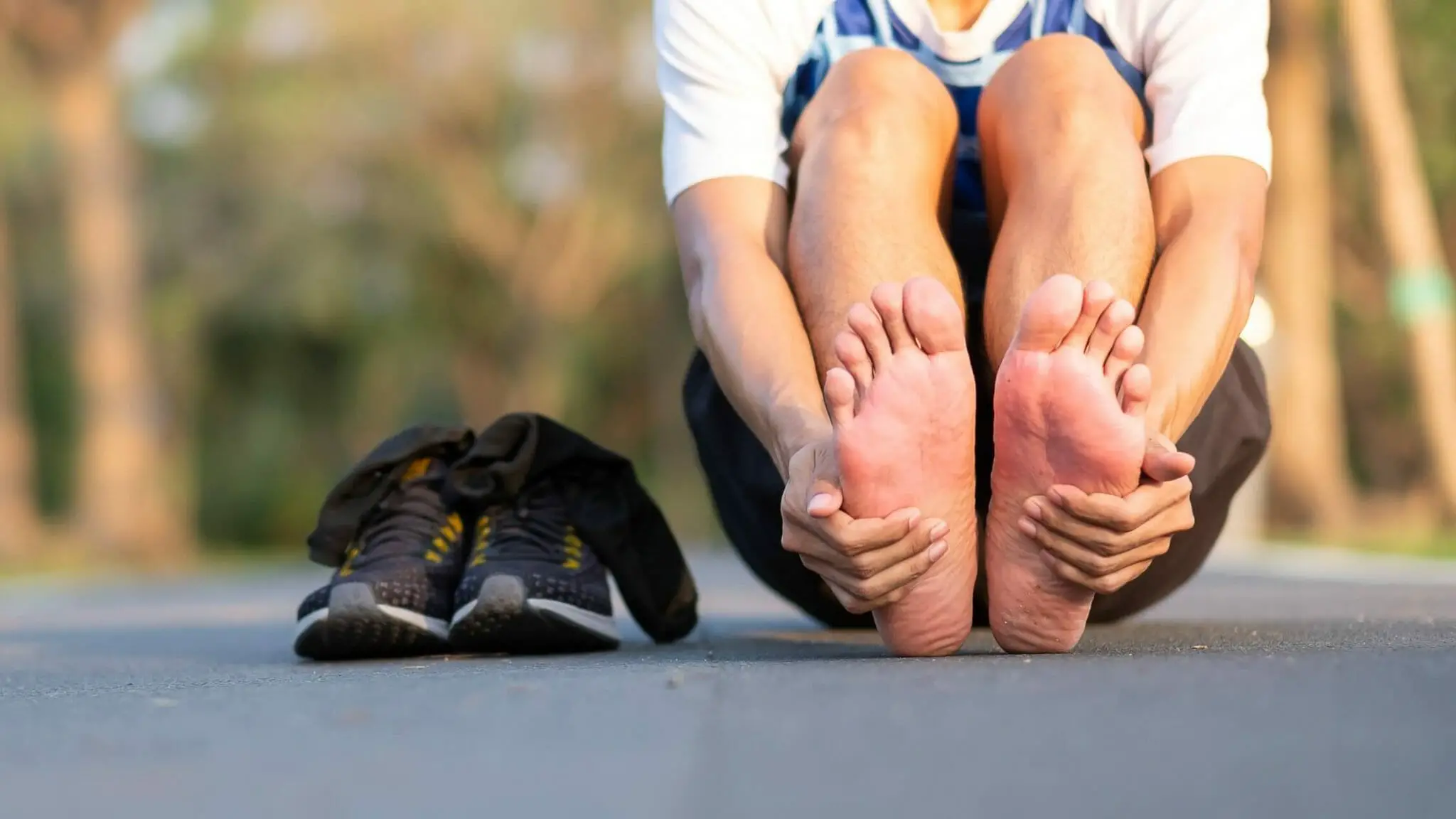
Determining if You Need Running Shoes for Flat Feet
We have noted three main methods to determine your foot type, and see if you suffer from flat footedness:
- Making standard observations
- Taking the wet foot test
- Measurements taken by a professional
Making Standard Observations
There are a few observations that can be made to determine if you have flat feet. While you are standing, it is possible to sometimes see if your inner foot flattens or arches. The simplest test to doing so is to try and push your big toe back as far as possible.
When doing this, if an arch appears, then your foot is flexible and normal. However, if the arch does not appear while flexing your big toe, it is likely that you might be flat footed. This is not a tell-all, though. In most cases, taking the wet foot test is a greater indicator of flat-footedness.
Taking the Wet Foot Test
The wet foot test is an incredibly simple method to get a stronger idea of what foot type you are. Generally, this is a more accurate indicator than the standard observation method above.
To perform the wet foot test, wet your feet and step onto a surface where you can see your footprint. In most cases, it is suggested to do this onto the top of a cardboard shoebox, as the contrast between wet and dry surfaces is obvious.
If your full footprint does not appear, your foot is flexible and normal. However, if your full footprint appears, it means you are likely flat footed. This is because the whole surface area of your sole will have pressed the water into the ground.
Measurements Taken by a Professional
This is always going to be the most accurate, telling method to determine flat footedness. A podiatrist, or even a professional in a shop specializing in running shoes will accurately and quickly measure your foot type and determine if you suffer from flat footedness.
If you are a runner diagnosed with flat feet, these professionals will often urge you to consider buying shoes specifically for flat footedness. This is especially important for running shoes. But why is it so important to use running shoes for flat feet?
Why Should I Use Specialized Running Shoes for Flat Feet?
Running on all surfaces, and especially on concrete, puts immense strain on ligaments, tendons, bones and muscles.
The arch of the foot serves to absorb the stress of impact that comes from each step. For this reason, lack of an arch causes far more stress on the heels and toes than those who have the support and flexibility of an arch.
This can lead to pain that radiates to multiple areas of the body, including the shins, ankles, Achilles tendon, arch, outer foot, calves, knees, hips, back and beyond.
We highly suggest going to a doctor or podiatrist if your feet remain painful, despite wearing supportive shoes like the ones we have suggested here at ShoeGuide. Remember, excessive over-exertion from those with flat feet can eventually lead to things such as Achilles tendonitis, bunions, and shin splints. We cannot recommend enough, if you still feel pain after changing up your shoe game, go see a professional.
The Arch of the Foot
The arch of the foot acts as a natural system of absorption for the rest of the body. It was designed over millions of years of evolution of the human body to do just that: absorb. When you shift your body weight over your feet, this shock is absorbed by the arch to lessen the impact and prevent subsequent injury. This shock which is absorbed by the arch would hit your ankles, knees, hips and back if not present.
Having flat feet is one of the telltale signals of over-pronation. This means, as outlined above, that the arch of the foot collapses when impacting the ground. Consequently, the ankle twists inwards, causing your knees to overcompensate.
This is something that should concern runners more so than most. Over the course of a run, the arch is meant to provide support to the pressure of the run. As a “run” is essentially thousands of small jumps onto one foot, the typical step supports up to three times the body weight in pressure. This is one of the main reasons why we suggest purchasing running shoes made specifically for those with flat feet. But there are factors to consider before deciding.
Factors to Consider Before Buying Running Shoes for Flat Feet
There are many factors that you need to consider before pulling the trigger on running shoes developed specifically for those with flat feet. Three of the most common variants between these shoes are pricing, styling, and structure. Let’s dig in a little more to each of these.
Pricing
Your budget plays a key role in determining the best running shoes for flat feet to buy. It is vital to note that both motion control and stability focused running shoes come at a greater expense than standard running shoes. This is due to better padding, a stronger frame, and sophisticated sole design (all things touched upon when considering structure below).
The additional upfront money is more than worth it to purchase running shoes for flat feet, as you will be taking better care of yourself, improving your running capabilities, reducing the chances of long term damage, and wear out shoes far less than standard running shoes.
Personal take: I have flat feet, and would go through the outside back heel of a running shoe within months. These were inexpensive running shoes, typically in the $50 to $70 range. I run an average amount, probably between 15 and 20 miles per week. The shoes would be unusable after four months. I bought a pair of $130 running shoes developed specifically for flat feet a year ago. They are still going strong, making the cost per day far less than the alternative, while keeping my health in check.
Styling
Running shoes for flat feet would generally be a little bit bulkier. This is mainly due to the additional padding and extra features that are crammed into the show. This means, if a light-minimalist styling is something that you desire, this is something you should likely deal with losing out on. But for a good reason.
While lightweight shoes look great, they lack the necessary support for flat footed runners, to prevent injury from over-pronation. It’s important to make comfort and support a priority over style. This ensures the most effective running experience with a lessened chance of long-term damage.
This being said, there are some incredibly good-looking shoes available for those with flat feet. Ten of them are outlined above.
Structure
As flat-footed runners will almost always wear the heels and toes of their running shoes far quicker than regular runners with standard arches, it is a smart idea to look for shoes with extra support in these areas. Additional heel and toe support leads to a shoe that lasts longer, providing better “bang for your buck” in running shoes.
Also, insoles should be considered when evaluating structure of shoes. Some flat-footed runners have had great success using insoles that stabilize both the arch and heel while running.
When it comes to purchasing running shoes for flat feet, ensure you select a high-quality product that was designed for high impact activities (e.g. running), as opposed to standard running shoes.
Getting the Best Running Shoes for Flat Feet: Pro Tips
Everything we’ve mentioned so far is important when looking to purchase running shoes to assist with flat-footedness issues. However, there are some additional pro tips that should be included, and should be considered part of your research.
Re-Measure Your Feet Often
It can be quite surprising just how much a foot can change, even over the course of one year. It is important to re-measure your feet every time you plan on making a new running shoe purchase. The purpose of this is to accurately adapt to any further changes in your foot, such as extended lowering of your arch.
If you started with stability-based running shoes, but your arch has dropped lower since then, it might be time to consider motion control shoes to alleviate any issues that might arise.
Ensure Proper Fit
Getting the right fit for your running shoes can sometimes be every bit as important as the show itself. Fitting that is not correct can lead to a wide variety of issues, ranging from calluses to even ingrown toenails.
Visit our six shoe fitting tips guide to ensure you cover all the basic requirements when selecting the perfect running shoes for flat feet.
Make Sure Your Running Shoes for Flat Feet Match Your Needs
Running surfaces and the weather in your area both play a key role when determining the perfect running shoes for flat feet. For example, if you run mainly on concrete or asphalt, you will want to purchase a shoe with more cushioning than if you tend to run in fields or on a treadmill.
Also, there is nothing worse when running than wet feet. If you find yourself frequently running in wet conditions, it would be advantageous to look for shoes that are waterproof, or at least water resistant.
There are plenty of solid options available for running shoes for flat feet. Make sure you utilize the above pro tips to get the proper shoe to meet your needs.
A Few Additional Tips for Dealing with Running Shoes for Flat Feet
Great! You’ve chosen the perfect pair of running shoes for flat feet. Does everything stop here? Absolutely not. Now you need to listen to your body and take proper care of your flat footedness.
One of the best ways to do this is to run barefoot. Adding in occasional running on soft surfaces (such as fields or beaches) stimulates arch strength and exercises the natural muscles of the foot. This improves the shock absorbing capacities of the arch over time.
Additionally, try intermittently utilizing a flexible, minimalist shoe such as the Nike Free. This works especially well if barefoot running is not a viable option, as it stimulates similar muscle groups.
Another great exercise to practice is picking up a ping pong ball with your toes. This is a very simple exercise that can be done by most anyone at any given time. We recommend doing so when amid a mindless task, like watching television. This exercise is a frequent recommendation of podiatrists and exercise professionals, and will provide incredible results over time.
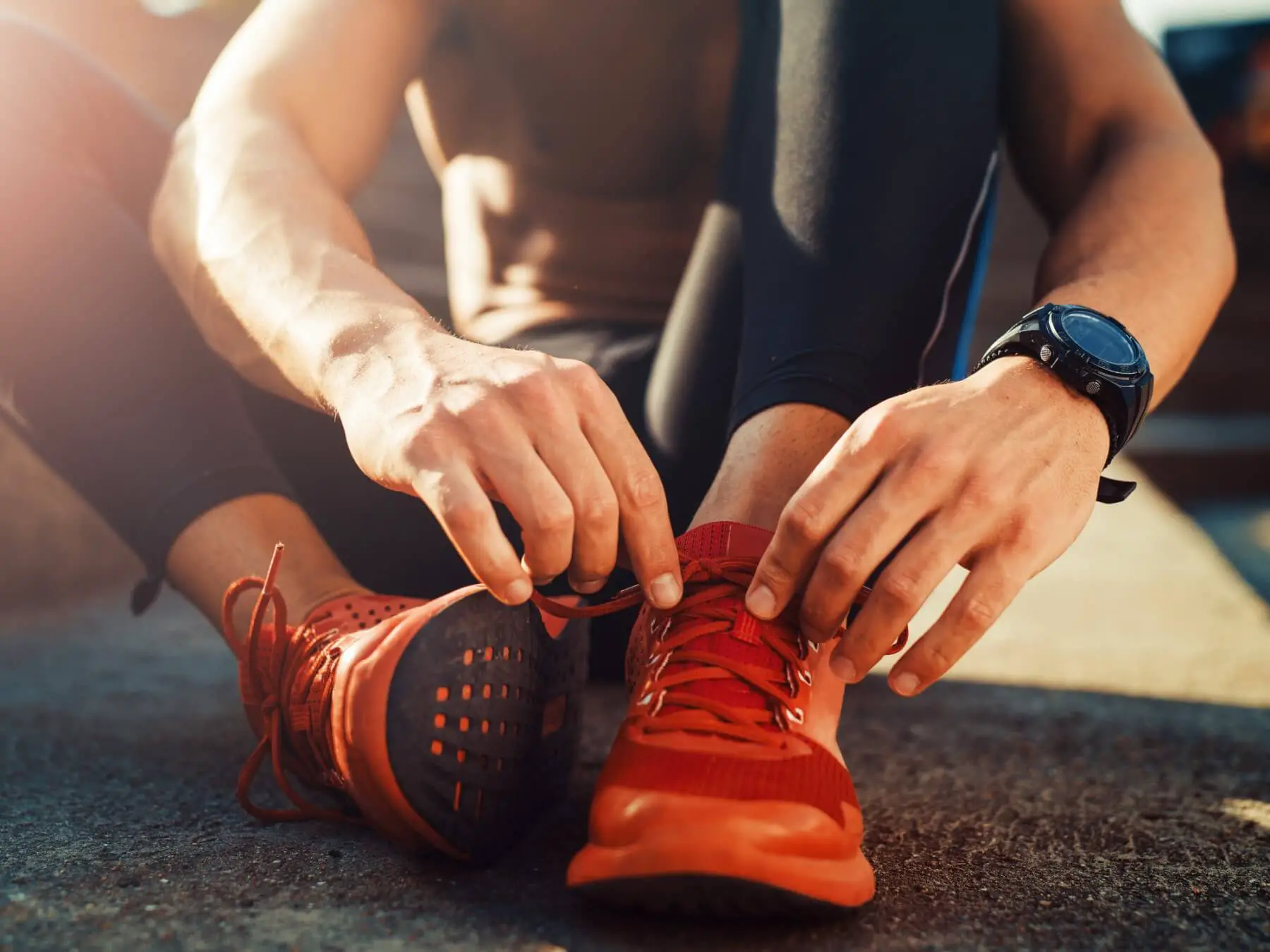
Next Steps to Take in Getting the Best Running Shoes for Flat Feet
We hope this ultimate guide to selecting the best running shoes for flat feet has been beneficial to you. Our reviews and comments were meant to guide you towards the realization that there are plenty of viable options for you out there, regardless of what you might have thought previously.
Remember, when training in a new pair of shoes (especially if you are going from standard running shoes to a pair of these running shoes made specifically for those with flat feet and over pronation) break them in slowly. You’ll be running in a fashion your body is not familiar with.
Once you get used to them, you may be surprised at the difference that is made to your running, and the benefits that will be running alongside you! Thanks for reading!


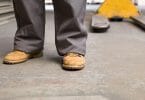

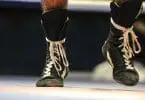
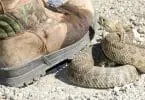
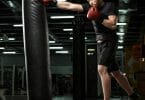
The Asics Gel series is really great, though I think it runs small one size. I tried the Saucony Ride 7, since a friend of mine runs in those. I’m interested, What do you think about that model for flat fleet?